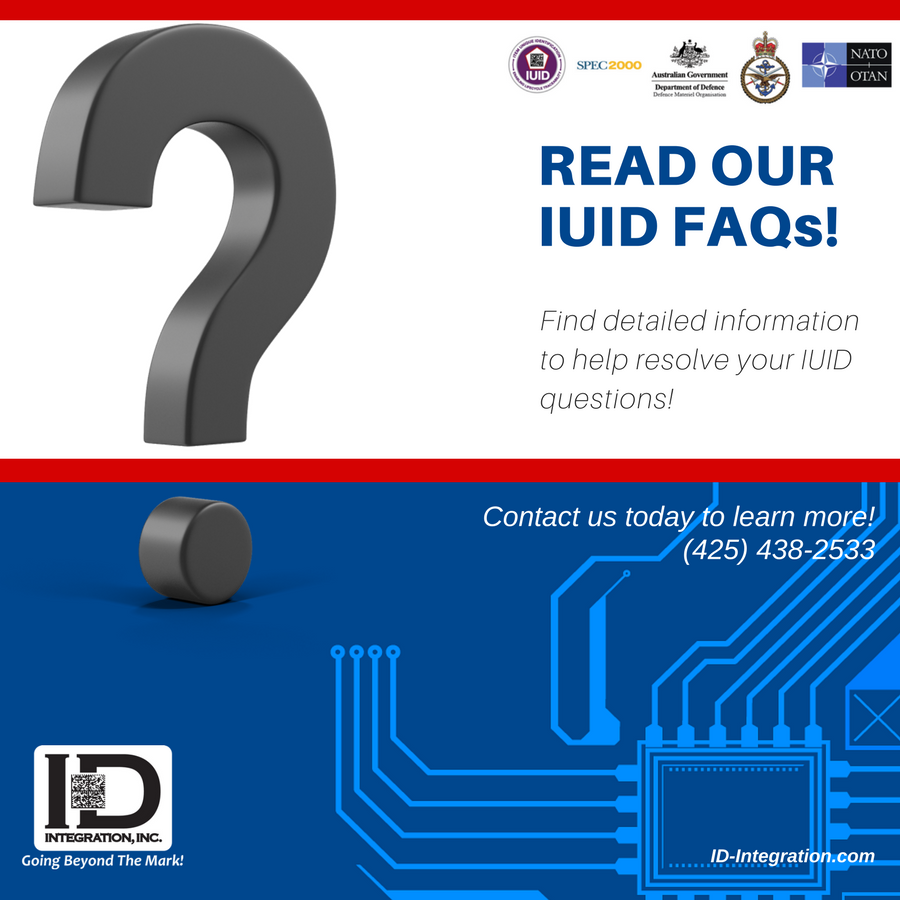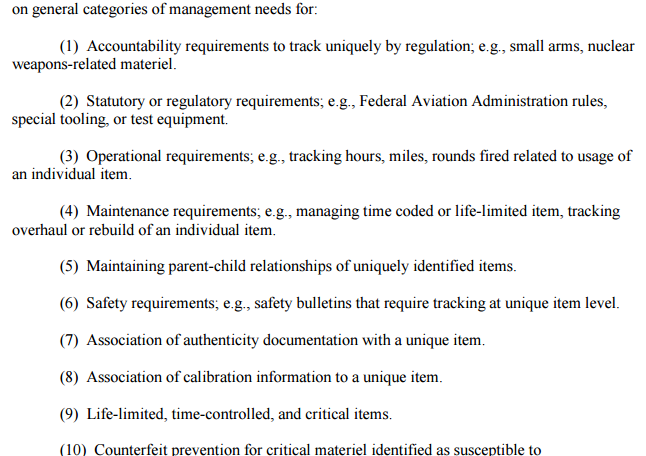IUID FAQs - Frequently Asked Questions
To understand how RFID innovations, speed up productivity, our team of experts offers answers to your most frequently asked questions.

The U.S. Department of Defense maintains Item Unique Identification, or IUID, standards that require suppliers and contractors to uniquely identify most tangible property, including components and kit parts, throughout an item’s full lifecycle of service. These standards ensure that many Department of Defense (DOD) assets are acquired, tracked, repaired, and deployed within a fast and efficient procedural framework that can uniquely track any asset’s history by accessing the identification information found on a particular item’s physical IUID marking, or label, and UII Unique Item Identifier (DOD UII Data Set).
A 2D Data Matrix barcode is required in the physical labeling and is encoded with data elements, that upon scanning with a 2D imager, reveal data identifying the Enterprise identifier, serial number, original part number, and more. The DOD maintains such a stringent set of specifications to ensure that every IUID asset transitions into their IUID Registry, and other relevant data resources, seamlessly – all data formatting standards meet these requirements, ensuring that the process is well understood and easily regulated for long-term success.
UID was the initial term for the DOD Program requiring Unique Item Identification for real and tangible property. In recent years, this term has been updated to IUID to better represent the standards for compliancy with Item Unique Item Identification for tangible property. (i.e., IUID Registry, DOD IUID Policy)
As updates to various documents become necessary, references to UID are updated to IUID.
Every compliant supplier is required to include IUID identification marking following specific nomenclature as described in the Department of Defense Guide to Uniquely Identifying Items. This physical mark must also include a properly encoded a 2D Data Matrix barcode. Finally, the supplier must prepare and submit a UII Data Set, or data file, to the IUID Registry for every IUID identified item that is delivered to the DOD.
✓ Every item DOD acquires over $5000 in value
✓ Embedded items, components, or sub-assemblies serially managed by DOD
✓ Critical items and items repaired by DOD
✓ Those general categories of management needs include the following –
These requirements were modified by Department of Defense INSTRUCTION NUMBER 8320.04 dated September 3, 2015. The new requirements are:

There is a wide range of IUID marking technologies available to accomplish required identification marks – either by Direct Part Marking (DPM) or marking and affixing permanent labels, nameplates, or tags. Often the best choice for marking is dependent on the substrate material of the item or label. Careful consideration of the marking method also evaluates the item’s production processes and usage environment to ensure IUID marks remain legible throughout the full lifecycle of service or use.
Proven IUID marking technologies:
✓ CO2, Nd:Yag, fiber or Vanadate laser
✓ Dot peen, programmable indenting
✓ Industrial inkjet with permanent inks
✓ Automated chemical etching
✓ High resolution ink stenciling
✓ Laser polymer bonding
✓ Thermal printing
✓ Metalphoto processing
✓ CerMark laser bonding material
Common label/nameplate/tag substrates:
✓ Anodized aluminum
✓ TESA and 3M laser markable tapes
✓ Polyester and polyimide labels
✓ Metalized polyester
✓ Photo sensitive aluminum (Metalphoto)
✓ Stainless steel
✓ Titanium
t is important to choose the Construct that reflects the serialization process used in the identification of the item.
Construct 1:
Serialization within the Enterprise.
If an item is serialized within the Enterprise, a Construct 1 syntax which includes:
✓ Enterprise identifier
✓ Original part number
should be employed.
Construct 2:
If an item is serialized within the part number, a Construct 2 syntax that includes:
✓ Enterprise identifier
✓ Original part number
✓ Serial number
should be employed.
No, IUID requirements do not exempt FMS contracts, these requirements apply to all DOD, Domestic, and FMS as well as small business or commercial items.
A UII file compliant with IUID syntax is required for every item delivered. This unique UII is derived from the data elements in the data set of the actual 2D Data Matrix barcode that’s marked or affixed to a particular item. The registered UII is the primary key field for each IUID identified asset in the DOD Registry.
We are more than willing to provide guidance and assistance for IUID applications. Our experts possess over 20 years of experience with DOD MIL SPEC, ATA SPEC 2000, and other asset identification specifications. Give us a call at (425) 438-2533 or email [email protected] to ask for help with your IUID application.
The decision between direct part marking (DPM) or labeling is typically dictated by:
✓ Durability requirements
✓ Space availability on the asset
Durability – Direct Part Marking technologies typically are more durable than nameplates or labels. If the asset is subject to harsh environmental conditions in service, DPM should be considered.
Space availability – If an asset is very small or has limited space available for a label or a nameplate, DPM may be the only marking technology that can produce an acceptable IUID mark.
Many companies outsource their IUID marking requirements. In these cases, we often recommend the business discuss their application needs with us or contact a trusted ID Integration partner who can provide IUID compliant nameplates and labels for a wide range of applications.
MIL-STD-130 requires that IUID Data Matrix markings meet minimum performance requirements. Because the costs and complication associated with DOD rejection, of a non-compliant IUID marking, it is highly recommended that businesses utilize a dependable IUID verification system as a critical phase in their IUID process; or require IUID verification proof from any companies producing labels, nameplates, and tags for IUID purposes. To learn more about barcode scanning and verification, read details on improving compliance here.
DEF STAN 05-132 is the United Kingdom’s version of IUID asset tracking. Although these guidelines have some similarities, there are also inherent differences. We recommend reading the Allied Unique Identification of Items Publication (AUIDP-1) for more complete information on NATO’s IUID solution. ID Integration can assist companies that are required to identify assets in compliance with DEF STAN 05-132.
Yes, there can be additional marking specifications for commercial aviation parts and for those used by foreign militaries. ID Integration, Inc. excels in providing solutions for complex applications which must meet multiple compliancy requirements. For a complete assessment of your company’s IUID, NASA, or ATA SPEC 2000 needs, contact ID Integration at (425) 438-2533. Our seasoned experts will help you to understand exactly what is required to meet current standards and how to meet compliance in the most cost-effective means possible.
The August 2014 changes have placed one additional hurdle in front of contractors for IUID compliancy. This means that contractors will now be required to adjust their systems to embed the UID information to Wide Area Workflow submissions. The Office of the Secretary of Defense states that, “WAWF allows one level of embedded items (up to 100). If an item has more than one level of embeds below the parent, the end item will be submitted via WAWF for acceptance, and the additional child/embedded item information will be entered directly to the IUID Registry.”
Do you have more questions about IUID system cost, installation, and implementation? Give us a call at 425-438-2533. We look forward to guiding you in your choice.
Read our 5 Minute Guide to IUID Basics infographic:

